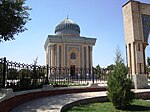|
Kutadgu Bilig
The Kutadgu Bilig[a] or Qutadğu Bilig (/kuːˈtɑːdɡuː ˈbɪlɪk/; Khaqani Turkic: [qʊtɑðˈɢʊ bɪˈlɪɡ]) is an 11th-century work written by Yūsuf Balasaguni for the prince of Kashgar. The text reflects the author's and his society's beliefs, feelings and practices with regard to quite a few topics and depicts interesting facets of various aspects of life in the Kara-Khanid Khanate. AuthorAt several points throughout the Kutadgu Bilig, the author talks some about himself; from this we know a certain amount about him. The author of the Kutadgu Bilig was named Yūsuf and was born in Balasagun, which at the time was the winter capital of the Karakhanid empire and was located near present-day Tokmok in Kyrgyzstan. He was about 50 years old when he completed the Kutadgu Bilig and upon presenting the completed work to the prince of Kashgar, was awarded the title Khāṣṣ Ḥājib (خاص حاجب), translating as something like "Privy Chamberlain" or "Privy Councilor".[3] He is often referred to as Yūsuf Khāṣṣ Ḥājib.[4] Some scholars suspect that the prologue to the Kutadgu Bilig, which is much more overtly Islamic than the rest of the text, was written by a different author—particularly the first prologue, which is in prose, unlike the rest of the text. TextHistoryThe Kutadgu Bilig was written in 1069-1070[5] and presented to Tavghach Bughra Khan, the prince of Kashgar. It was well known through the Timurid era (Dankoff, 3), but only three manuscripts—referred to by the name of the city they were discovered in—survived to give us our modern knowledge of the text:
LanguageThe Kutadgu Bilig is written in a Karluk language known as the "Karakhanid language" but often simply referred to as "Middle Turkic". It's similar to the language of the Orkhon inscriptions, in Old Turkic, but in addition to the Turkic base, has a large influx of Persian vocabulary. Aside from specific vocabulary from Arabic and Persian, Dankoff mentions a good number of calques in the language of the Kutadgu Bilig from Persian. One of the features of the language of Karakhanid is that its 3rd person imperative always has /s/ instead of /z/ and around half of the Brahmi instances are not -zUn but -sUn. This is often rendered as sU in Kutadgu Bilig: kutadsu atı bersü iki cihân bayat ok bolu bersü arka yölek tuta bersü teŋri bu taht birle baht The following is the excerpt from the Kutadgu Bilig; the first column is the text in the original (Karluk or Middle Turkic) language, but transliterated into Turkish (Latin) letters. Second column is the text's Turkish translation,[6] while the third one is its English translation.
Despite the prevalence of Islamic wisdom from hadiths and the Qurʻān, Persian calques and Arabic and Persian vocabulary, there are no specific references to Islamic texts, nor are Arabic and Persian words used for Islamic concepts. This strengthens the argument that Islam came into Central Asia through wandering Sufis. StyleThe author of the Kutadgu Bilig used the Arabic mutaqārib metre, consisting of couplets of two rhyming 11-syllable lines, often broken down further—the first six syllables forming the first group in each line and the last five syllables forming another group. This is the earliest known application of this metre to a Turkic language. The original metre is composed of preceding short and long vowels:
Since Turkic language did not differentiate between short and long vowels, he transformed them to open and close syllables, for example:
(The snow molten, the earth full of fragrance, taking off the winter clothes, the world is in new elegance. ——Kutadgu Bilig·Volume 4·2) ContentThe Kutadgu Bilig is structured around the relations between four main characters, each representing an abstract principle (overtly stated by the author). Dankoff summarises the specifics nicely in the form of a chart (Dankoff, 3):
InfluencesDankoff suggests that the author of the Kutadgu Bilig was attempting to reconcile the Irano-Islamic and Turkic wisdom traditions present among the Karakhanids, the former with urban roots and the latter with nomadic roots. Certainly the recent move from a more nomadic way of life changed the requirements for a good leader; the Kutadgu Bilig's agenda does appear to include instruction for how to be a good leader. In addition, the author of the Kutadgu Bilig states in the text that he was trying to make a Turkic version of something like the Shāh-nāmeh.
Aside from the Irano-Islamic and Turkic influences, Dankoff posits some amount of Greek and Buddhist influence on the text. Selected Online Resources
See alsoNotesReferencesCitations
Bibliography
|
|||||||||||||||||||||||||||||||||||||||||||||||||||||||||||||||||||||||||||||

